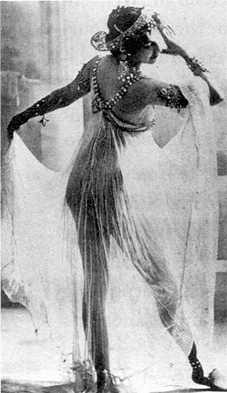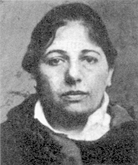 |

|
|||
![[COMMERCE]](../../commercebut.gif) |
![[CULTURE]](../../culturebut02.gif) |
![[HEALTH]](../../healthbut.gif) |
![[LAW]](../../lawbut.gif) |
|
 |

|
|||
![[COMMERCE]](../../commercebut.gif) |
![[CULTURE]](../../culturebut02.gif) |
![[HEALTH]](../../healthbut.gif) |
![[LAW]](../../lawbut.gif) |
|

An Underground Education By Richard Zacks Spies with a twist
|
|
“Mata Hari personifies all the poetry of India, its mysticism, its voluptuousness, its langour, its hypnotizing charm,” raved Le Journal. “To see Mata Hari … is an unforgettable spectacle, a paradiselike dream.” |
And a German general concluded: “Innumerable tall tales were concocted about the German secret service … like the one about the unfortunate Mata Hari, who, in reality, did absolutely nothing for the German espionage effort.”
Mata Hari (Malayan for “dawn”) claimed that she was raised in Java by temple priests, taught to dance naked, and then later rescued by an English officer who fell in love with her religious gyrations.
“Mata Hari personifies all the poetry of India, its mysticism, its voluptuousness, its langour, its hypnotizing charm,” raved Le Journal. “To see Mata Hari … is an unforgettable spectacle, a paradiselike dream.”
Not everyone, however, was seduced. The writer Colette cattily reported overhearing a spectator say: “She an Oriental? Don't be silly! Hamburg or Rotterdam, or possibly Berlin.” Almost none of the breathless men and women worshipping the exotic dancer had a clue about her real origins.

Mata Hari (1876–1917) was actually born Margaretha Geertruida Zelle in Leeuwarden, Holland. She was nineteen when she met her husband, Rudolph MacLeod, through a personals ad in the newspaper — “army officer seeks companion.” The wild, liberated girl followed him to his post in Java; she remained there a few years, grew to despise the brutal strict man, and eventually fled to the stages of Paris. All her Orientalism was rehearsed seductive claptrap: a stage persona that didn't end at the stage door. After a few years of dancing success, she tried to segue to the role of Grand Dancer of the Theatre, calling herself “Lady MacLeod.” She importuned Richard Strauss to compose a Salome for her; she sought out Diaghilev to let her join Ballet Russe. And while she played a few opera houses in Italy and performed at some notorious private parties, even riding naked at a lesbian fete in Paris, Mata Hari never made that final leap to serious world-class actress.
By 1915, the thirty-nine-year-old exotic dancer was hitting midlife; her career was waning and she was devolving into a Holly-Go-Lightly or what the French call a “grande horizontale,” i.e., a horizontally talented courtesan maintained by a wealthy patron. Despite a parade of wealthy foreign lovers into her bedroom, she was constantly running up debts.
With World War I brutalizing the continent, the British arrested her and accused her of being a spy named Clara Benedix but they couldn't make the charge stick.
The French arrested her and tossed her in St. Lazares. Her valises were searched and they tried to prove that two jars of unusual ointments contained disappearing ink. It turned out that one was a spermicide and the other a morning-after contraceptive douche. Her body was searched because several lovers said that even in bed, she never removed her upper garment, a cotton cache-sein (breast coverlet). Was there some German tattoo? Some cubby for secrets? No, said her longtime doctor, she has very small breasts with large discoloured nipples which she prefers not to reveal to anyone.
Here is how her supposedly unbiased French interrogator later described her in his memoirs: “Had she been pretty? Without a doubt, [judging] from her passport photo. But this woman … in my office … had suffered many affronts from time.” He described her bloodshot eyes as “big as eggs”; she had a “bulbous nose, chapped skin, a mouth that touched the ears, the swollen lips of a negress, teeth as big as plates … graying hair no longer covered by dye.” (tr. Julie Wheelwright)
The French produced coded messages from the Germans allegedly outlining the hiring of the cash-short courtesan but they never produced any evidence of her having delivered anything to the Germans. Apparently, Mata Hari, who had made a career out of manipulating men, was simply playing the Germans for 20,000 francs. “ Commandant von Kalle,” she explained, “not wanting to pay for my caresses with his own money, found it easier to let his government pay for them.”
In fact, she had delivered information to the French and had been vaguely promised a lucrative assignment to spy for them. Broke yet again, she had returned to France to cash in on that offer.
Instead, she wound up facing the firing squad. She didn't know that French Counter-Intelligence had had two men tail her for six months.
Why was she convicted? Blame it on the desperate mind-set in France in 1917 reeling from a failed offensive and battling outright mutinies among the troops. And blame it on the human nature of a pair of vindictive French officers who seemed to have delighted in crushing this former femme fatale, now forty-one and broke and a bit desperate.
Spymaster Ladoux must produce something after investigating her for six months. Prosecutor Bouchardon couldn't let this bed-hopping spy escape.
Her trial was a sham of pre-ordained military justice; she was forbidden to call any civilian witnesses.
Legend has it that Mata Hari stalled the firing squad by unbuttoning her dress, that at first no man would shoot. Here's what really happened.

On October 15, 1917, at dawn, Mata Hari — clothed in a long pearl-gray dress, elegant buttoned gloves, lace-up boots and a tricornered felt hat — was tied with a single rope around her waist to a post. She refused to be blindfolded or to have her hands tied behind her back. She waved to the weeping nuns who had accompanied her from prison.
She died bravely.
When curiosity seekers went days later to a grave set aside for her, they found it empty. Rumours of her escape began. In later years, Mata Hari sightings would crop up in the press. The truth? In war-torn France, no one was courageous enough to claim her body and pay for a burial. The presiding officers ordered her body to be delivered to the dissecting room at the University of Paris medical school.
Name another female spy besides Mata Hari.
Ethel Rosenberg? Doesn't have quite the same ring. The Mata Hari myth will die hard.
![[Whore Heros]](mataharibut1.gif)
|
|
Created: February 20, 2004 Last modified: February 20, 2004 |
 |
Commercial Sex Information Service Box 3075, Vancouver, BC V6B 3X6 Tel: +1 (604) 488-0710 Email: csis@walnet.org |